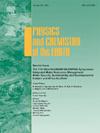Theoretical basis and analyses of temperature responses of water-saturated rocks to rapid changes in confining pressure
IF 3
3区 地球科学
Q2 GEOSCIENCES, MULTIDISCIPLINARY
引用次数: 0
Abstract
The temperature response of water-saturated rocks to stress changes is critical for understanding thermal anomalies in the crust, because most porous rocks in the shallow crust are saturated with water. Based on the adiabatic effective stress law and porothermoelasticity theory, we derived the adiabatic pressure derivative of temperature (β = (∂T/∂P)s) of water-saturated rock (βwet) in terms of that of dry rock (βdry) and water (βdry), and other measurable physical parameters. Then, we calculated the ranges of βwet for 15 representative water-saturated rocks at background temperature (T0) between 23 and 50°C. The results showed that βwet (1.58–10.79 mK/MPa) was greater than βdry (1.52–6.15 mK/MPa) for all rocks. The ratio of βwet to βdry is more significant for rocks with higher compressibility. For instance, for rocks with drained bulk modulus no more than 10 GPa, βwet at 50°C (10.71 mK/MPa for Berea sandstone) can be as much as twice of βdry at 23°C (5.86 mK/MPa). Also, βwet was observed to linearly increase with the increase of T0. The theory allows us to gain understanding on the coseismic temperature responses, such as the temperature anomalies documented in boreholes drilled through seismically ruptured active faults after the Chi-Chi, Wenchuan, and Tohoku earthquakes.
饱和水岩石对围压快速变化温度响应的理论基础与分析
饱和水岩石对应力变化的温度响应对于理解地壳中的热异常至关重要,因为浅层地壳中的大多数多孔岩石都是饱和水的。基于绝热有效应力定律和孔隙热弹性理论,推导了饱和岩石(β湿)温度(β =(∂T/∂P)s对干岩石(β干)和水(β干)温度(β =(∂T/∂P)s)和其他可测物理参数的绝热压力导数。然后,我们计算了背景温度(T0)在23 ~ 50°C之间的15个代表性水饱和岩石的βwet范围。结果表明:所有岩石的β湿型(1.58 ~ 10.79 mK/MPa)均大于干型(1.52 ~ 6.15 mK/MPa);对于压缩性较高的岩石,β湿与β干的比值更为显著。例如,对于排水体积模量不超过10 GPa的岩石,在50°C (Berea砂岩为10.71 mK/MPa)下的β湿可以达到23°C (5.86 mK/MPa)下β干的两倍。βwet随T0的增加呈线性增加。该理论使我们能够了解同震温度响应,例如在Chi-Chi,汶川和东北地震后,通过地震破裂的活动断层钻孔记录的温度异常。
本文章由计算机程序翻译,如有差异,请以英文原文为准。
求助全文
约1分钟内获得全文
求助全文
来源期刊

Physics and Chemistry of the Earth
地学-地球科学综合
CiteScore
5.40
自引率
2.70%
发文量
176
审稿时长
31.6 weeks
期刊介绍:
Physics and Chemistry of the Earth is an international interdisciplinary journal for the rapid publication of collections of refereed communications in separate thematic issues, either stemming from scientific meetings, or, especially compiled for the occasion. There is no restriction on the length of articles published in the journal. Physics and Chemistry of the Earth incorporates the separate Parts A, B and C which existed until the end of 2001.
Please note: the Editors are unable to consider submissions that are not invited or linked to a thematic issue. Please do not submit unsolicited papers.
The journal covers the following subject areas:
-Solid Earth and Geodesy:
(geology, geochemistry, tectonophysics, seismology, volcanology, palaeomagnetism and rock magnetism, electromagnetism and potential fields, marine and environmental geosciences as well as geodesy).
-Hydrology, Oceans and Atmosphere:
(hydrology and water resources research, engineering and management, oceanography and oceanic chemistry, shelf, sea, lake and river sciences, meteorology and atmospheric sciences incl. chemistry as well as climatology and glaciology).
-Solar-Terrestrial and Planetary Science:
(solar, heliospheric and solar-planetary sciences, geology, geophysics and atmospheric sciences of planets, satellites and small bodies as well as cosmochemistry and exobiology).
 求助内容:
求助内容: 应助结果提醒方式:
应助结果提醒方式:


